Abstract
The interaction of symptomatology (rigidity/chorea) in Huntington's disease (HD) with age of onset (AO) was examined using data from the Research Roster for Huntington's Disease Patients and Families. It was shown that AO varies between families and between paternal and maternal transmission and that rigidity is associated specifically with very early onset, major anticipation, paternal transmission, and young parental AO. It is proposed that AO depends on the state of methylation of the HD locus, which varies as a familial trait, and as a consequence of 'genomic imprinting' determined by parental transmission. Young familial AO and paternal imprinting interact to produce, occasionally, a major change in gene expression, that is, the early onset/rigid variant.
Full text
PDF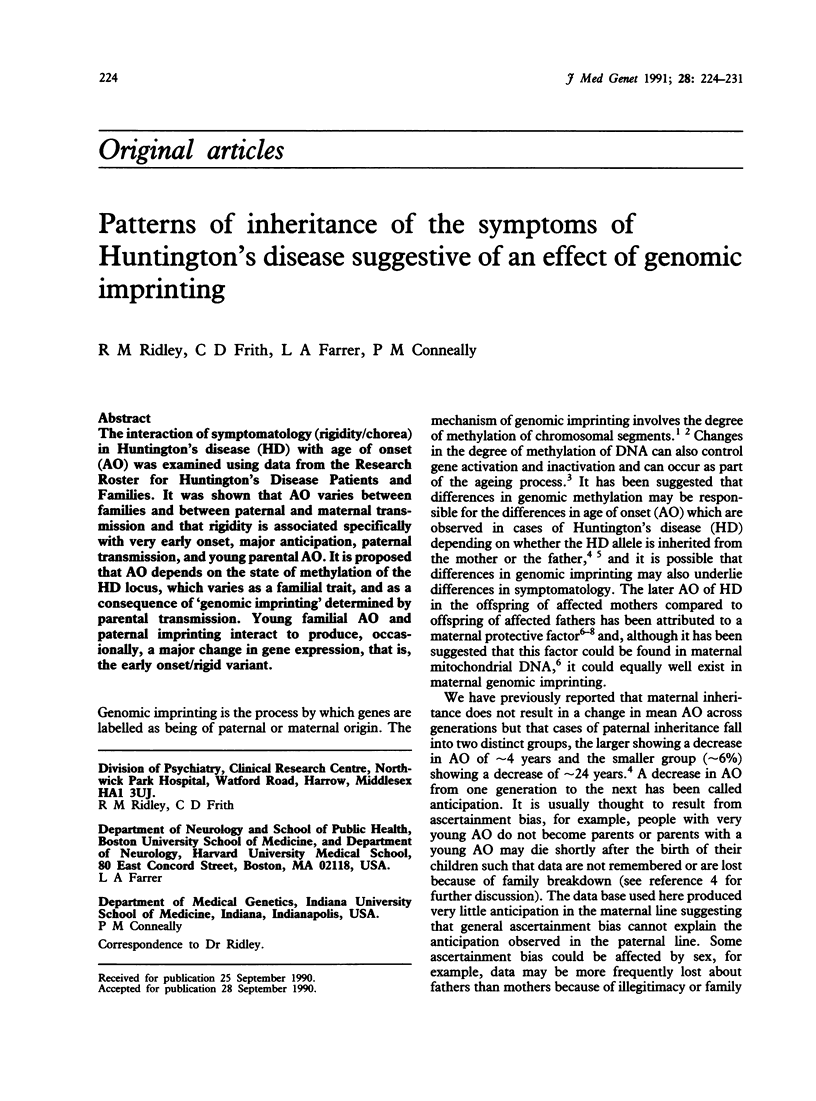
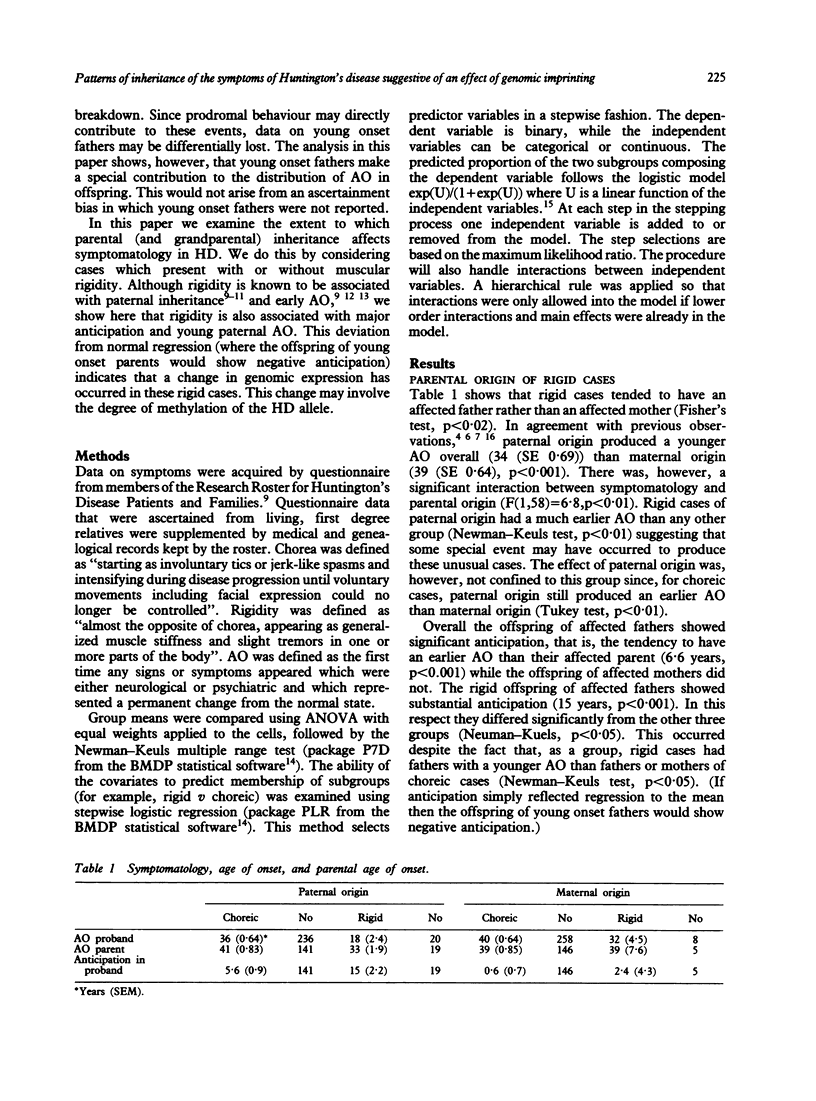
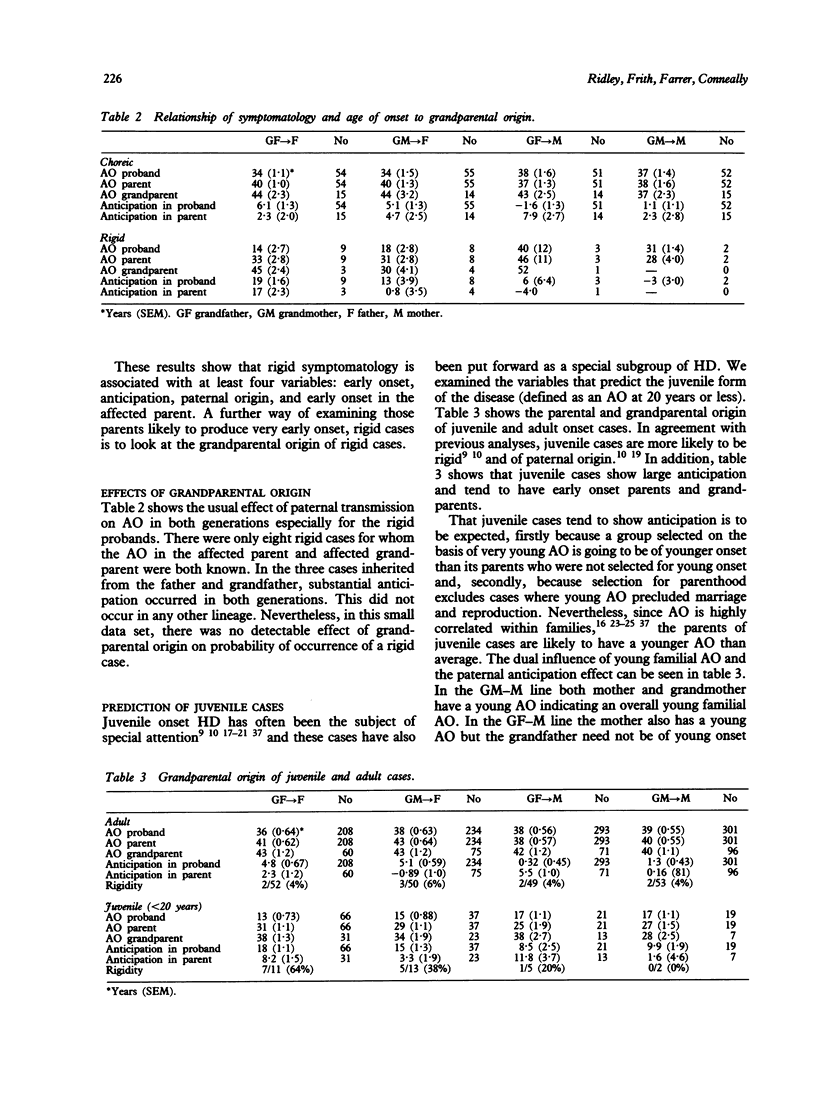
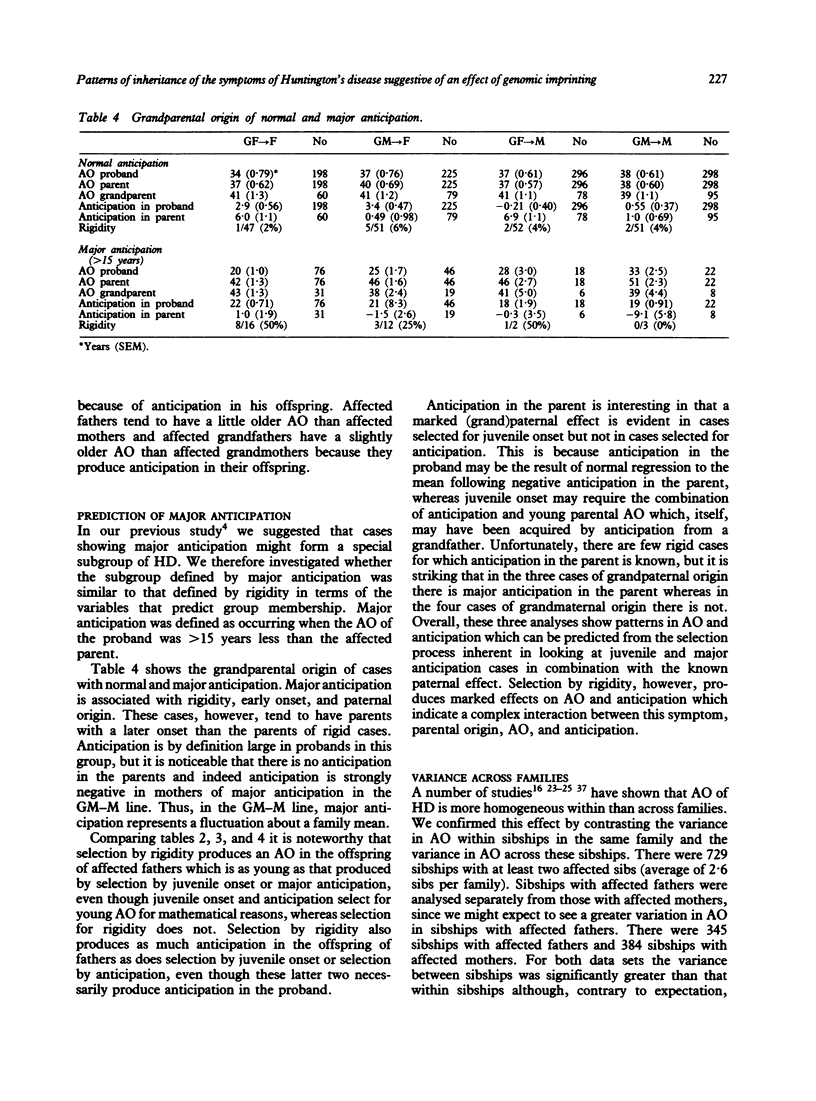
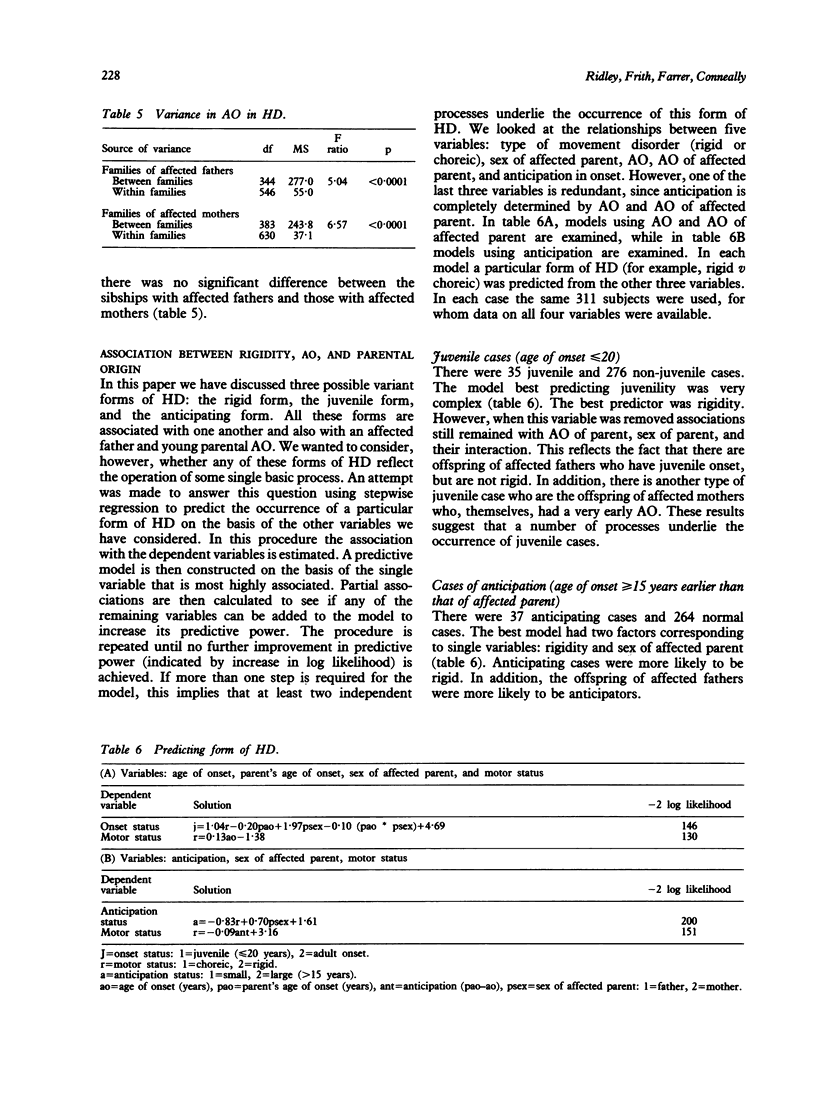
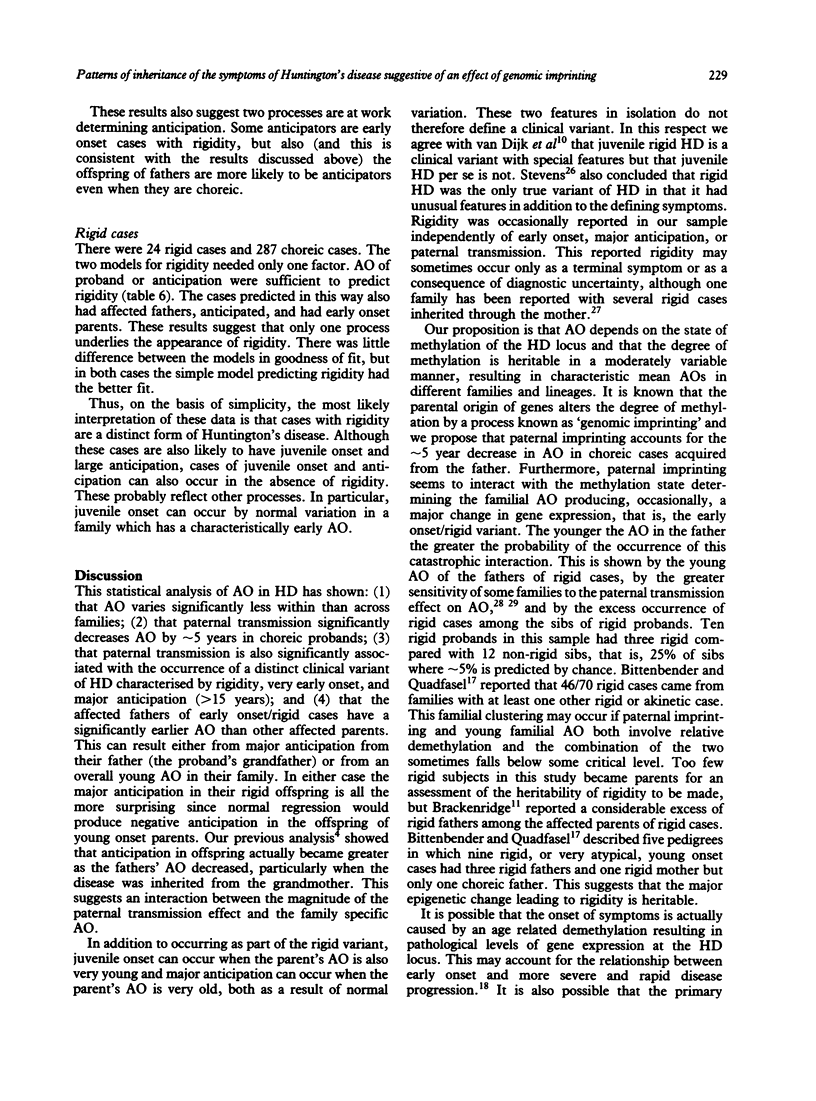
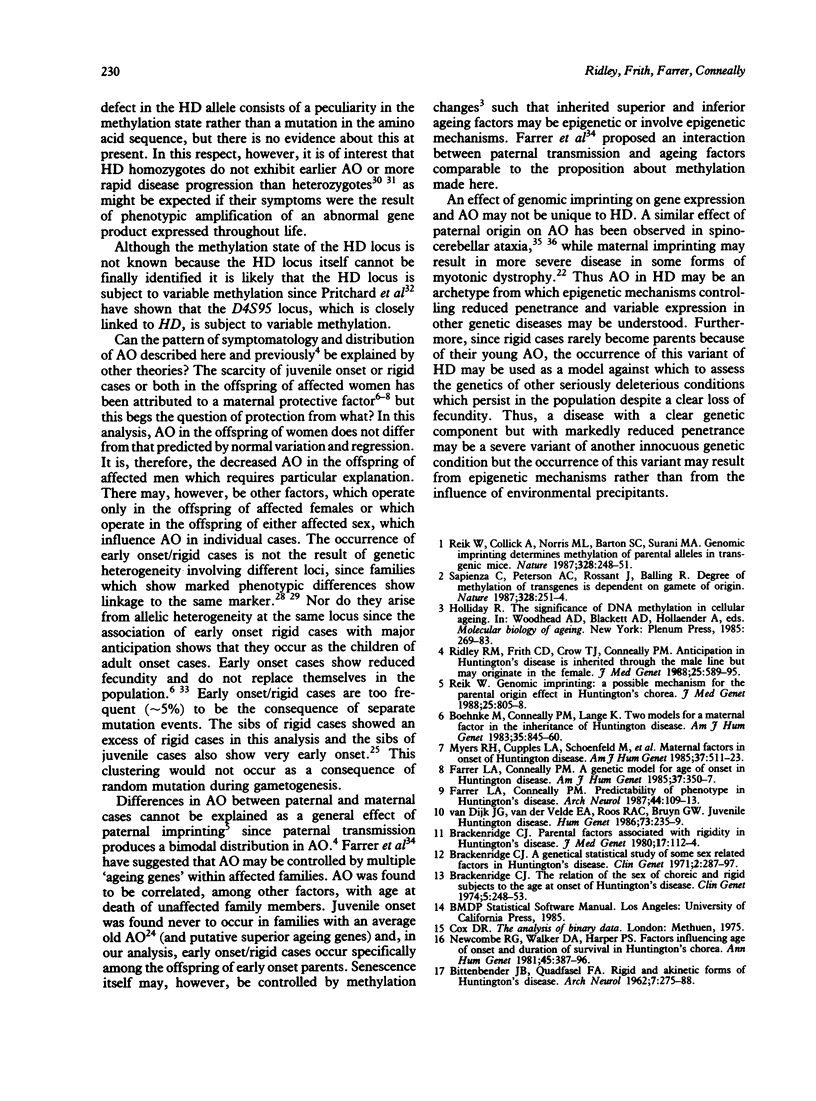
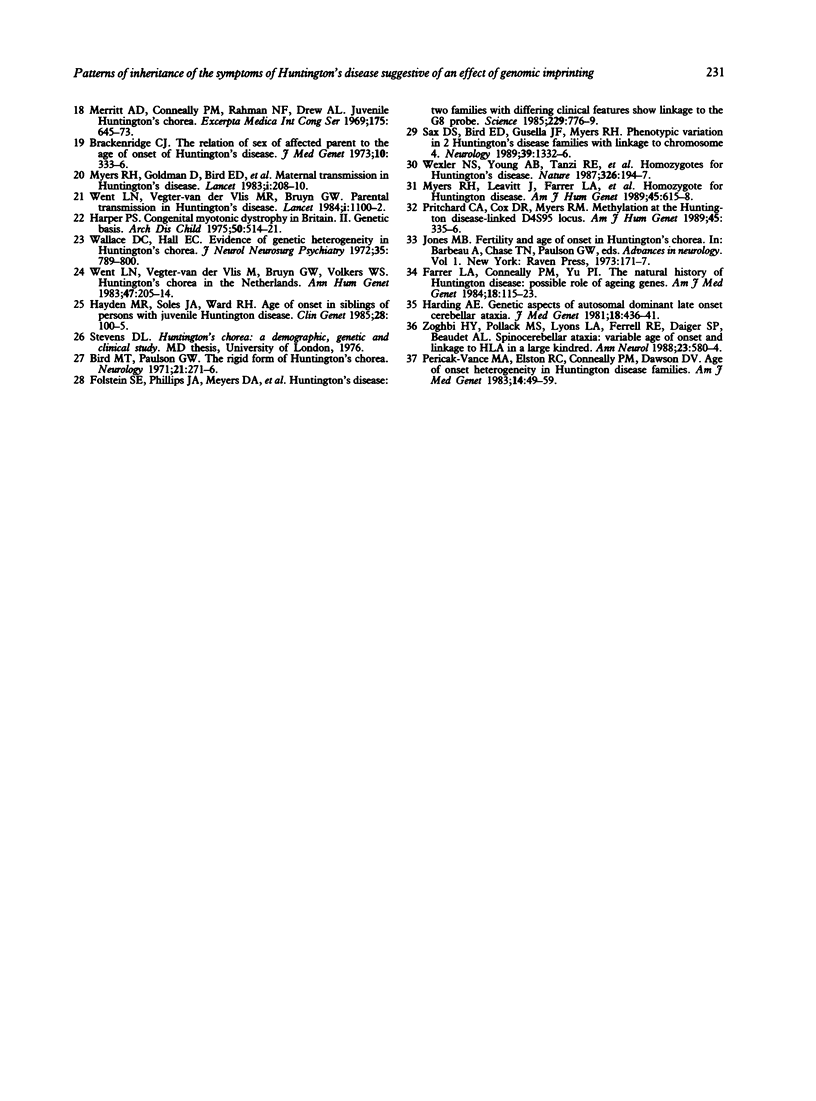
Selected References
These references are in PubMed. This may not be the complete list of references from this article.
- Bird M. T., Paulson G. W. The rigid form of Huntington's chorea. Neurology. 1971 Mar;21(3):271–276. doi: 10.1212/wnl.21.3.271. [DOI] [PubMed] [Google Scholar]
- Boehnke M., Conneally P. M., Lange K. Two models for a maternal factor in the inheritance of Huntington disease. Am J Hum Genet. 1983 Sep;35(5):845–860. [PMC free article] [PubMed] [Google Scholar]
- Brackenbridge C. J. The relation of sex of affected parent to the age at onset of Huntington's disease. J Med Genet. 1973 Dec;10(4):333–336. [PMC free article] [PubMed] [Google Scholar]
- Brackenridge C. J., Chamberlin M. The relation of the sex of choreic and rigid subjects to the age at onset of Huntington's disease. Clin Genet. 1974;5(3):248–253. doi: 10.1111/j.1399-0004.1974.tb01690.x. [DOI] [PubMed] [Google Scholar]
- Brackenridge C. J. Parental factors associated with rigidity in Huntington's disease. J Med Genet. 1980 Apr;17(2):112–114. doi: 10.1136/jmg.17.2.112. [DOI] [PMC free article] [PubMed] [Google Scholar]
- Brackenridge C. J. The relation of type of initial symptoms and line of transmission to ages at onset and death in Huntington's disease. Clin Genet. 1971;2(5):287–297. doi: 10.1111/j.1399-0004.1971.tb00289.x. [DOI] [PubMed] [Google Scholar]
- Farrer L. A., Conneally P. M. A genetic model for age at onset in Huntington disease. Am J Hum Genet. 1985 Mar;37(2):350–357. [PMC free article] [PubMed] [Google Scholar]
- Farrer L. A., Conneally P. M. Predictability of phenotype in Huntington's disease. Arch Neurol. 1987 Jan;44(1):109–113. doi: 10.1001/archneur.1987.00520130083023. [DOI] [PubMed] [Google Scholar]
- Farrer L. A., Conneally P. M., Yu P. L. The natural history of Huntington disease: possible role of "aging genes". Am J Med Genet. 1984 May;18(1):115–123. doi: 10.1002/ajmg.1320180115. [DOI] [PubMed] [Google Scholar]
- Folstein S. E., Phillips J. A., 3rd, Meyers D. A., Chase G. A., Abbott M. H., Franz M. L., Waber P. G., Kazazian H. H., Jr, Conneally P. M., Hobbs W. Huntington's disease: two families with differing clinical features show linkage to the G8 probe. Science. 1985 Aug 23;229(4715):776–779. doi: 10.1126/science.2992086. [DOI] [PubMed] [Google Scholar]
- Harding A. E. Genetic aspects of autosomal dominant late onset cerebellar ataxia. J Med Genet. 1981 Dec;18(6):436–441. doi: 10.1136/jmg.18.6.436. [DOI] [PMC free article] [PubMed] [Google Scholar]
- Harper P. S. Congenital myotonic dystrophy in Britain. II. Genetic basis. Arch Dis Child. 1975 Jul;50(7):514–521. doi: 10.1136/adc.50.7.514. [DOI] [PMC free article] [PubMed] [Google Scholar]
- Hayden M. R., Soles J. A., Ward R. H. Age of onset in siblings of persons with juvenile Huntington disease. Clin Genet. 1985 Aug;28(2):100–105. doi: 10.1111/j.1399-0004.1985.tb00367.x. [DOI] [PubMed] [Google Scholar]
- Myers R. H., Cupples L. A., Schoenfeld M., D'Agostino R. B., Terrin N. C., Goldmakher N., Wolf P. A. Maternal factors in onset of Huntington disease. Am J Hum Genet. 1985 May;37(3):511–523. [PMC free article] [PubMed] [Google Scholar]
- Myers R. H., Leavitt J., Farrer L. A., Jagadeesh J., McFarlane H., Mastromauro C. A., Mark R. J., Gusella J. F. Homozygote for Huntington disease. Am J Hum Genet. 1989 Oct;45(4):615–618. [PMC free article] [PubMed] [Google Scholar]
- Newcombe R. G., Walker D. A., Harper P. S. Factors influencing age at onset and duration of survival in Huntington's chorea. Ann Hum Genet. 1981 Oct;45(Pt 4):387–396. doi: 10.1111/j.1469-1809.1981.tb00352.x. [DOI] [PubMed] [Google Scholar]
- Pericak-Vance M. A., Elston R. C., Conneally P. M., Dawson D. V. Age-of-onset heterogeneity in Huntington disease families. Am J Med Genet. 1983 Jan;14(1):49–59. doi: 10.1002/ajmg.1320140109. [DOI] [PubMed] [Google Scholar]
- Pritchard C. A., Cox D. R., Myers R. M. Methylation at the Huntington disease-linked D4S95 locus. Am J Hum Genet. 1989 Aug;45(2):335–336. [PMC free article] [PubMed] [Google Scholar]
- Reik W., Collick A., Norris M. L., Barton S. C., Surani M. A. Genomic imprinting determines methylation of parental alleles in transgenic mice. Nature. 1987 Jul 16;328(6127):248–251. doi: 10.1038/328248a0. [DOI] [PubMed] [Google Scholar]
- Reik W. Genomic imprinting: a possible mechanism for the parental origin effect in Huntington's chorea. J Med Genet. 1988 Dec;25(12):805–808. doi: 10.1136/jmg.25.12.805. [DOI] [PMC free article] [PubMed] [Google Scholar]
- Ridley R. M., Frith C. D., Crow T. J., Conneally P. M. Anticipation in Huntington's disease is inherited through the male line but may originate in the female. J Med Genet. 1988 Sep;25(9):589–595. doi: 10.1136/jmg.25.9.589. [DOI] [PMC free article] [PubMed] [Google Scholar]
- Sapienza C., Peterson A. C., Rossant J., Balling R. Degree of methylation of transgenes is dependent on gamete of origin. Nature. 1987 Jul 16;328(6127):251–254. doi: 10.1038/328251a0. [DOI] [PubMed] [Google Scholar]
- Sax D. S., Bird E. D., Gusella J. F., Myers R. H. Phenotypic variation in 2 Huntington's disease families with linkage to chromosome 4. Neurology. 1989 Oct;39(10):1332–1336. doi: 10.1212/wnl.39.10.1332. [DOI] [PubMed] [Google Scholar]
- Wallace D. C., Hall A. C. Evidence of genetic heterogeneity in Huntington's chorea. J Neurol Neurosurg Psychiatry. 1972 Dec;35(6):789–800. doi: 10.1136/jnnp.35.6.789. [DOI] [PMC free article] [PubMed] [Google Scholar]
- Went L. N., Vegter-van der Vlis M., Bruyn G. W. Parental transmission in Huntington's disease. Lancet. 1984 May 19;1(8386):1100–1102. doi: 10.1016/s0140-6736(84)92510-8. [DOI] [PubMed] [Google Scholar]
- Went L. N., Vegter-van der Vlis M., Bruyn G. W., Volkers W. S. Huntington's Chorea in the Netherlands. The problem of genetic heterogeneity. Ann Hum Genet. 1983 Jul;47(Pt 3):205–214. doi: 10.1111/j.1469-1809.1983.tb00989.x. [DOI] [PubMed] [Google Scholar]
- Wexler N. S., Young A. B., Tanzi R. E., Travers H., Starosta-Rubinstein S., Penney J. B., Snodgrass S. R., Shoulson I., Gomez F., Ramos Arroyo M. A. Homozygotes for Huntington's disease. Nature. 1987 Mar 12;326(6109):194–197. doi: 10.1038/326194a0. [DOI] [PubMed] [Google Scholar]
- Zoghbi H. Y., Pollack M. S., Lyons L. A., Ferrell R. E., Daiger S. P., Beaudet A. L. Spinocerebellar ataxia: variable age of onset and linkage to human leukocyte antigen in a large kindred. Ann Neurol. 1988 Jun;23(6):580–584. doi: 10.1002/ana.410230609. [DOI] [PubMed] [Google Scholar]
- van Dijk J. G., van der Velde E. A., Roos R. A., Bruyn G. W. Juvenile Huntington disease. Hum Genet. 1986 Jul;73(3):235–239. doi: 10.1007/BF00401235. [DOI] [PubMed] [Google Scholar]


